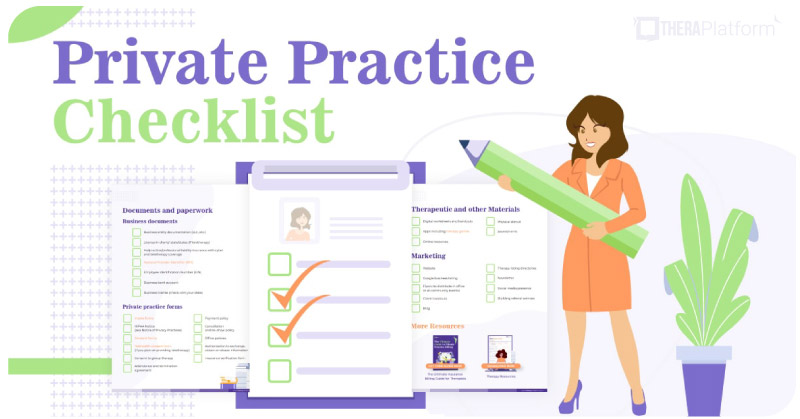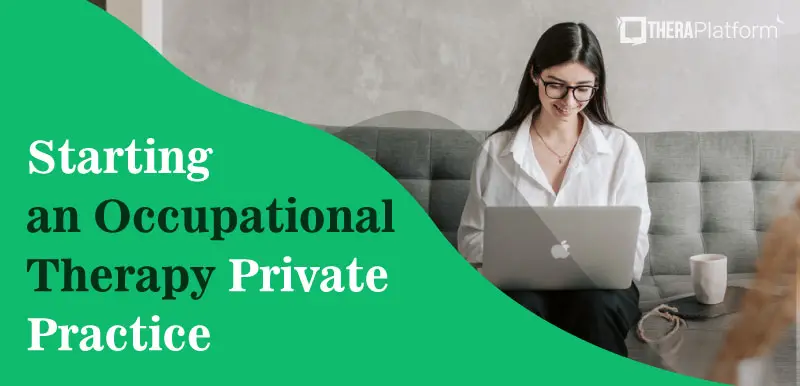5 Tips for Occupational Therapy Private Practice

Now more than ever, therapists are shifting their views about going into private practice. In this changing economy, therapists desire control of their workload, flexibility over their schedule, higher reimbursement, and the ability to incorporate evidence-based practice without unrealistic productivity standards. Occupational therapists in private practice can make a more significant impact on their clients and put their creative skills to use. Using a private practice model to improve their quality of life alongside their clients is a win-win for many occupational therapists.
There are many considerations to make, however, before leaping into private practice. Read on to explore resources about building a private practice and questions you should ask yourself to develop your practice foundation.
1.Referrals
Clients are the heart of occupational therapy private practices. Consider what type of clients you'd like to serve. The possibilities are endless and could include individuals with neurological impairments, pediatric clients, individuals with learning disabilities, adults with mental health challenges, homebound individuals, older adults, and more. Be sure to do a market analysis to assess the need for services in your area. If you are pursuing outpatient pediatrics and there are already several clinics in your geographical location, you may want to reconsider. The specific location can be less of an issue for providers who decide to use a hybrid or virtual model.
Once you know the population you'd like to work with, consider how you will obtain referrals to your practice—interested in working with older adults? Reach out to your local agency on aging, fall prevention groups, local geriatricians, and community groups. Credentialing with various insurances, including Medicaid and Medicare, can also be a great source of referrals for therapists just starting. Connect with other professionals in your practice area for ideas specific to your location: Social workers, community health workers, and case managers are a great place to start.
As you become more established, however, by providing excellent services to your existing clients, the value of your services will be communicated back to physicians and facilities and result in more referrals.
2. Service Offerings
Once you have a specific clientele in mind, brainstorm the services that you can provide. OT services commonly reimbursable include therapeutic activities, sensory integration, self-care, manual therapy, or work reintegration training. See our post on CPT Codes for Occupational Therapy for more information. However, if you want to set yourself apart from the competition, consider adding something outside of the box! A pediatric outpatient clinic may offer a weekend event to teach children how to ride a bicycle, or an OT specializing in geriatrics can offer a weekend seminar about taking care of aging parents. The options are limitless, and this can be an excellent way to get your name out into the community while making an impact. While unique service offerings are less likely to be reimbursed by traditional payors, they can serve as a cash-based supplement to your business income. As a bonus, some of these clients may even transition to conventional therapy.
If you have or are interested in pursuing a niche area, consider getting further education resulting in a certificate or credential. You can offer these services to your clients as another way to set yourself apart from the competition. For example, a therapist certified in Learning Without Tears, biofeedback, or even Neuro-Developmental Treatment (NDT) can offer services related to that credential. As a bonus, in most cases, you’ll be listed as a provider on their directory, resulting in another possible avenue for referrals.

Download free private practice checklist

3. Documentation
All private practice owners need to uphold their commitment to the occupational therapy code of ethics. Using ethical practices protects you, your client, and the profession as a whole. Among other vital principles, this includes committing to using evidence-based practice, refraining from actions that cause harm, honoring autonomy, protecting privacy, confidentiality, and obtaining informed consent.
New private practitioners will feel confident when they know that all of these boxes are checked. Wiley Treatment Planners can do that work for you so you can spend your time and energy elsewhere. Their Treatment Planner offers customized treatment plans, thousands of templates, evidence-based objectives, and even solutions for carryover outside of therapy.
One of the biggest challenges of occupational therapists and other specialists is ensuring complete, accurate, and timely documentation. Wiley Treatment Planners make daily documentation and even initial evaluations much more straightforward. You can select pre-made goals and objectives and even interventions from a bank of targeted choices for assessments. This option also offers prompts that will help ensure that you don't miss any essential information, such as the frequency and duration of therapy or the CPT code. Make sure that nothing is missing on your documentation so that not only will you get compensated, but so that the documentation stands up to reviewers and audits. You can save yourself time and effort through Wiley Treatment Planners and TheraPlatform. [KB1]
4. Coordinating staff
As your private practice becomes reputable, you'll come to a point where you cannot continue to grow without hiring other staff. Office administrators and additional therapists can handle scheduling, reimbursement, credentialing, licensing, and remove clients from your waitlist. Before you post a help wanted ad, it’s essential to dig into the responsibilities that you need to delegate. If you can provide your staff with clear expectations at onboarding, you'll have more success in managing your team from the start.
Create systems: Use email and documentation templates to save your employees time and headache. For example, what will staff do when the team gets a referral? Create a multiple-step list (including assigning to a therapist, coordinating schedules, checking reimbursement, etc.) This way, no step will be overlooked. You can start to do this as soon as you decide you are getting ready to start hiring.
Manage paperwork: Documentation is a crucial aspect of the therapy process that makes your practice legal and credible. Consider using an all-inclusive EMR to ensure that no paper goes unsigned. TheraPlatform offers documentation, intake paperwork, billing, treatment planning, and more.
Unite under a common goal: Define and reinforce the mission of your practice. Remind staff of the impact they make on their clients and communities. Provide positive feedback and recognize employees when they excel.
Lead by example: Set the bar high for all of your employees. Model the client interactions that you want to see in your staff and get your documentation done promptly. Others will follow your lead. Make yourself available to answer questions to create a collaborative working environment.
Retain staff: Create support systems for staff, especially new grads. Offer structured mentorship to recruit staff and help them deliver the excellent services you want your business to be associated with.
Staying solo? It is even more essential to create systems and use an all-in-one EMR to keep organized. When systems are in place, you can boost productivity while remaining confident that everything is accounted for.
Practice Management + EHR + Telehealth
Mange more in less time in your practice with TheraPlatform

.
5. Location
Occupational therapy services continue to become more accessible thanks to digital technology and teleconferencing software. The profession is responding to this by advocating for license portability (OT practitioners can use their OT license across state lines). For updated information on the interstate professional licensing compact, visit AOTA. This newfound flexibility in service delivery can give you options for treatment and open up your services to clients in different regions.
Are you interested in offering hybrid programming? Coordinate with another therapist to secure a space and then decide which days you’ll each be using it. You can even reach out to therapists with existing practices to see if they have room. Sharing space is an excellent way to try out a hybrid model and save some money when starting. Leasing a treatment area alongside a hybrid or part-time speech-language pathologist or physical therapist can be an excellent way for you both to share referrals. Some hybrid therapists choose to evaluate in person and then switch to virtual services for intervention. This can make therapy accessible to those who have busy schedules or are further away from your physical location. However, the primary benefit of the hybrid model is that you can do what works best for your client depending on their needs.
Many occupational therapists are moving to exclusively remote services. While it may be more hands-off, providing virtual intervention in the context of the client's own home or workspace offers an incredible advantage. Pair this benefit with the added technology of built-in apps, not needing to commute, and it is a service that OTs will continue to provide, and clients will continue to seek out.
Conclusion
By making a plan to get client referrals, offering needed services, standardizing documentation, coordinating staff, and considering location options; you'll be well on your way to creating a successful model for your private practice.
TheraPlatform is fully integrated teletherapy and practice management software designed for occupational therapists! Start your therapy practice strong with HIPAA-compliant video conferencing, electronic documentation, a client portal, billing, scheduling, apps for intervention, and more! TheraPlatform, an all-in-one EHR, practice management and teletherapy tool was built for therapists to help them save time on admin tasks. Sign up for a free, 30-day trial with no credit card required. Cancel anytime.
I hope you find these five tips helpful for your practice. If you do, leave us a comment and let us know what’s working for you!
Visit the TheraPlatform resource center today to find free worksheets, templates, exercises, apps, and more.
More resources
- Therapy resources and worksheets
- Therapy private practice courses
- Ultimate teletherapy ebook
- The Ultimate Insurance Billing Guide for Therapists
- The Ultimate Guide to Starting a Private Therapy Practice
Free video classes
- Free mini video lessons to enhance your private practice
- 9 Admin tasks to automate in your private practice



